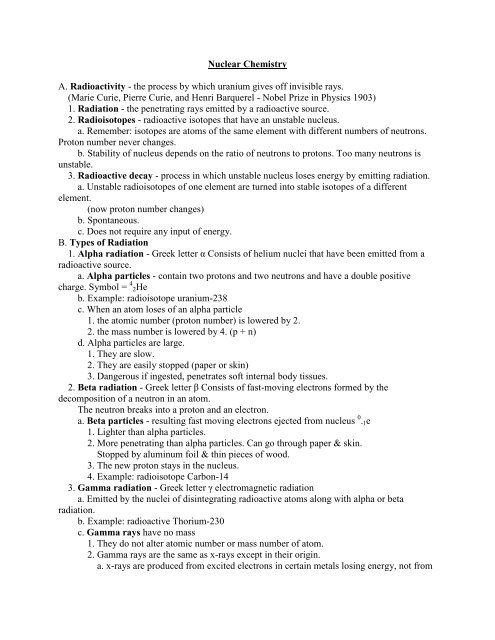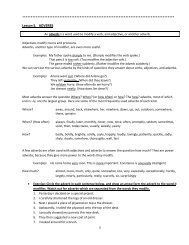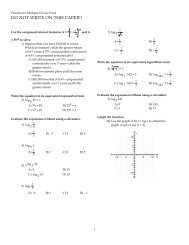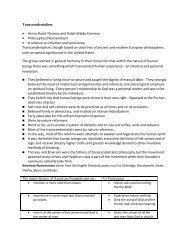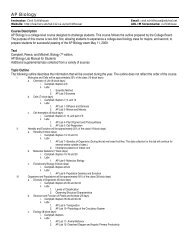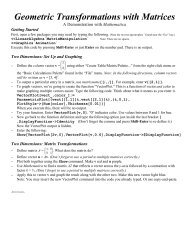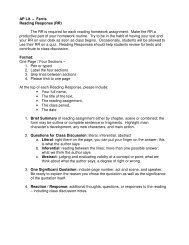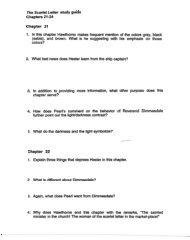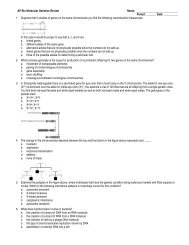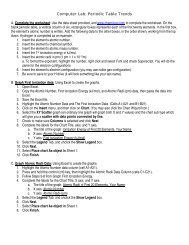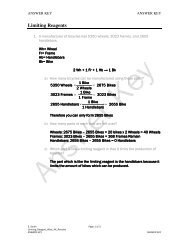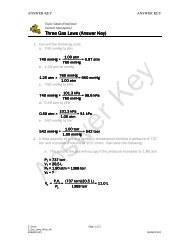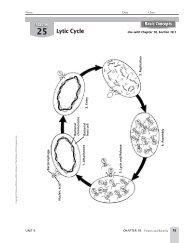You also want an ePaper? Increase the reach of your titles
YUMPU automatically turns print PDFs into web optimized ePapers that Google loves.
<strong>Nuclear</strong> <strong>Chem</strong>istry<br />
A. Radioactivity - the process by which uranium gives off invisible rays.<br />
(Marie Curie, Pierre Curie, and Henri Barquerel - Nobel Prize in Physics 1903)<br />
1. Radiation - the penetrating rays emitted by a radioactive source.<br />
2. Radioisotopes - radioactive isotopes that have an unstable nucleus.<br />
a. Remember: isotopes are atoms of the same element with different numbers of neutrons.<br />
Proton number never changes.<br />
b. Stability of nucleus depends on the ratio of neutrons to protons. Too many neutrons is<br />
unstable.<br />
3. Radioactive decay - process in which unstable nucleus loses energy by emitting radiation.<br />
a. Unstable radioisotopes of one element are turned into stable isotopes of a different<br />
element.<br />
(now proton number changes)<br />
b. Spontaneous.<br />
c. Does not require any input of energy.<br />
B. Types of Radiation<br />
1. Alpha radiation - Greek letter α Consists of helium nuclei that have been emitted from a<br />
radioactive source.<br />
a. Alpha particles - contain two protons and two neutrons and have a double positive<br />
charge. Symbol = 4 2He<br />
b. Example: radioisotope uranium-238<br />
c. When an atom loses of an alpha particle<br />
1. the atomic number (proton number) is lowered by 2.<br />
2. the mass number is lowered by 4. (p + n)<br />
d. Alpha particles are large.<br />
1. They are slow.<br />
2. They are easily stopped (paper or skin)<br />
3. Dangerous if ingested, penetrates soft internal body tissues.<br />
2. Beta radiation - Greek letter β Consists of fast-moving electrons formed by the<br />
decomposition of a neutron in an atom.<br />
The neutron breaks into a proton and an electron.<br />
a. Beta particles - resulting fast moving electrons ejected from nucleus 0 -1e<br />
1. Lighter than alpha particles.<br />
2. More penetrating than alpha particles. Can go through paper & skin.<br />
Stopped by aluminum foil & thin pieces of wood.<br />
3. The new proton stays in the nucleus.<br />
4. Example: radioisotope Carbon-14<br />
3. Gamma radiation - Greek letter γ electromagnetic radiation<br />
a. Emitted by the nuclei of disintegrating radioactive atoms along with alpha or beta<br />
radiation.<br />
b. Example: radioactive Thorium-230<br />
c. Gamma rays have no mass<br />
1. They do not alter atomic number or mass number of atom.<br />
2. Gamma rays are the same as x-rays except in their origin.<br />
a. x-rays are produced from excited electrons in certain metals losing energy, not from
adioactive decay<br />
b. Both gamma and x-rays pass easily through paper, the skin, and wood.<br />
c. They can be stopped, but not completely by several meters of concrete or several<br />
centimeters of lead<br />
C. <strong>Nuclear</strong> Stability 1500 nuclei are known - 264 are stable- stability depends on the proton to<br />
neutron ratio<br />
up to AN 20 the ratio is 1:1 (p :n) above AN 20 the ratio reaches 1:1.5<br />
1. Band of stability - a neutron verses proton plot of stable nuclei.<br />
a. Nuclei that fall outside the band of stability undergo spontaneous radioactive decay.<br />
b. The type of decay depends on the position of the nucleus with respect to the band of<br />
stability.<br />
2. Beta decay (or beta emission) - To the left of the band of stability, (region A) the nuclei<br />
have too many neutrons. They<br />
turn a neutron into a proton be emitting an electron (beta decay).<br />
3. To the right of the band of stability (region B) the nuclei have too many protons. They<br />
convert a proton to a neutron by<br />
capturing an electron.<br />
a. Positron - a particle with the mass of an electron but a positive charge.<br />
1. A positron may be emitted as a proton is converted to a neutron.<br />
2. When a proton is converted to a neutron<br />
3. the AN (protons) decreases by one<br />
4. the mass (p + n) stays the same<br />
4. At the upper end of the band of stability (region C), the nuclei have too many protons and<br />
too many neutrons<br />
(very heavy).<br />
a. Alpha Emission - they emit alpha particles.<br />
1. The mass number decreases by 4<br />
2. The AN decreases by 2.<br />
b. All nuclei with an AN greater than 83 are radioactive. The majority of these undergo<br />
alpha emission.<br />
D. Half-Life - the time required for one-half of the atoms of a radioisotope to emit radiation and<br />
to decay to products.<br />
1. After one half-life - one-half of the original atoms have decayed into a new element. Onehalf<br />
remain unchanged.<br />
a. After a second half-life only one quarter of the original atoms remain unchanged.100 --><br />
50 -->25 --> 12 --> etc.<br />
2. Half-lives can be as short as a fraction of a second or as long as several million years.<br />
a. Artificial radioisotopes have very short half-lives. Good for nuclear medicine.<br />
b. It is possible to use this method to date rocks as old as our solar system.<br />
E. Transmutation Reactions<br />
1. Transmutation - the conversion of an atom of one element to an atom of another element.<br />
a. Can be done through radioactive decay.<br />
b. Can also occur if the nucleus is bombarded with high energy protons, neutrons or alpha<br />
particles.<br />
c. Can occur in nature and be done in labs.<br />
2. Transuranium elements - the elements in the periodic table with atomic numbers above
92.<br />
a. None occur in nature.<br />
b. All are radioactive.<br />
F. <strong>Nuclear</strong> Fission<br />
1. Fission - when the nuclei of certain isotopes are bombarded with neutrons, they split into<br />
smaller fragments.<br />
a. Nucleus breaks into smaller pieces.<br />
b. Neutrons are released, striking other atoms and creating a chain reaction.<br />
c. Unleashes an enormous amount of energy.<br />
d. If uncontrolled the energy release is instantaneous. (Atomic Bombs)<br />
2. Control of Fission - releasing the energy more slowly. Done by nuclear reactors to produce<br />
useful energy.<br />
a. <strong>Nuclear</strong> Power Plant<br />
- Much of the energy is generated as heat.<br />
- The heat is removed by coolant fluid.<br />
- Steam is generated to drive the turbine.<br />
- A spinning turbine generates electricity.<br />
b. Steps to controlling fission ... prevents the reactor from overheating<br />
a. Neutron moderation - slows down the neutrons so that they can be captured by the<br />
reactor fuel to continue the<br />
chain reaction. (carbon and water)<br />
b. Neutron absorption - decreases the number of slow neutrons to prevent the chain<br />
reaction from going too fast.<br />
(cadmium).<br />
G. <strong>Nuclear</strong> Fusion<br />
1. Fusion - occurs when two nuclei combine to produce a nucleus of heavier mass.<br />
a. The sun - solar fusion - two hydrogen nuclei fuse to form a single helium nucleus.<br />
b. Releases more energy than fission.<br />
c. Can only occur at an extremely high temperature - greater than 40 million degrees<br />
Celsius. SUN<br />
H. Detecting Radiation - radiation cannot be seen, heard, felt, or smelled.<br />
1. Ionizing Radiation - radiation with enough energy to knock electrons off some atoms of<br />
the bombarded substance to<br />
produce ions. Cannot detect with your five senses. The following monitoring devices are<br />
not protection against radiation.<br />
a. Geiger Counter - gas-filled metal tube to detect radiation.<br />
- used for detecting beta radiation<br />
- gas gets ionized when beta radiation penetrates glass<br />
- gas flows, current flows, electronic counters click<br />
b. Scintillation Counter - device that uses a specially coated phosphor surface to detect<br />
radiation.<br />
- detect all types of radiation<br />
- radiation hits the phosphor surface and produces bright flashes of light, scintillations<br />
- the light is converted to electronic pulses which are measured and recorded<br />
- television screens - scintillations produce picture<br />
c. Film Badge - layers of film covered with black lightproof paper in plastic holder
- film is removed and developed at regular intervals<br />
- strength and type of radiation are determined by the darkening film.<br />
I. Using Radiation<br />
1. Neutron Activation - detects trace (small) amounts of elements in samples<br />
- bombard sample with neutrons causing them to become radioactive<br />
- the half-life and type of radiation emitted is unique for each element<br />
2. Radio-isotope Tracers<br />
a. Reactions - one reactant is labeled, after the reaction takes place, the amount of the tracer<br />
in the product is measured.<br />
- learn about reaction mechanism (many steps)<br />
b. Agriculture Research - tests the effects of herbicides, pesticides, and fertilizers<br />
- tracer connects to substance being tested, plants are treated with the radioactive<br />
substance, measure location and<br />
quantity taken up by the plant - also monitor animals, water, and soil<br />
c. Disease Diagnosis - Iodine-131 detects thyroid problems<br />
- Technetium-99m detects brain tumors and liver disorders<br />
- Phosphorus-32 detects skin cancer<br />
3. Cancer Treatments -<br />
a. Cancer - abnormal cells produced at a faster rate than healthy cells<br />
b. Tumor - runaway growth of cancerous cells in one area.<br />
c. fast-growing cancer cells are damaged more than healthy cells by gamma radiation<br />
d. Gamma radiation will also kill healthy cells to some degree<br />
e. applied with a laser beam, or implanted salt/gold tubes<br />
<strong>Nuclear</strong> <strong>Chem</strong>istry<br />
A. Radioactivity - the process by which uranium gives off invisible rays.<br />
(Marie Curie, Pierre Curie, and Henri Barquerel - Nobel Prize in Physics 1903)<br />
1. Radiation - the penetrating rays emitted by a radioactive source.<br />
2. Radioisotopes - radioactive isotopes that have an unstable nucleus.<br />
a. Remember: isotopes are atoms of the same element with different numbers of neutrons.<br />
Proton number never changes.<br />
b. Stability of nucleus depends on the ratio of neutrons to protons. Too many neutrons is<br />
unstable.<br />
3. Radioactive decay - process in which unstable nucleus loses energy by emitting radiation.<br />
a. Unstable radioisotopes of one element are turned into stable isotopes of a different<br />
element.<br />
(now proton number changes)<br />
b. Spontaneous.<br />
c. Does not require any input of energy.<br />
B. Types of Radiation<br />
1. Alpha radiation - Greek letter α Consists of helium nuclei that have been emitted from a<br />
radioactive source.<br />
a. Alpha particles - contain two protons and two neutrons and have a double positive<br />
charge. Symbol = 4 2He<br />
b. Example: radioisotope uranium-238
c. When an atom loses of an alpha particle<br />
1. the atomic number (proton number) is lowered by 2.<br />
2. the mass number is lowered by 4. (p + n)<br />
d. Alpha particles are large.<br />
1. They are slow.<br />
2. They are easily stopped (paper or skin)<br />
3. Dangerous if ingested, penetrates soft internal body tissues.<br />
2. Beta radiation - Greek letter β Consists of fast-moving electrons formed by the<br />
decomposition of a neutron in an atom.<br />
The neutron breaks into a proton and an electron.<br />
a. Beta particles - resulting fast moving electrons ejected from nucleus 0 -1e<br />
1. Lighter than alpha particles.<br />
2. More penetrating than alpha particles. Can go through paper & skin.<br />
Stopped by aluminum foil & thin pieces of wood.<br />
3. The new proton stays in the nucleus.<br />
4. Example: radioisotope Carbon-14<br />
3. Gamma radiation - Greek letter γ electromagnetic radiation<br />
a. Emitted by the nuclei of disintegrating radioactive atoms along with alpha or beta<br />
radiation.<br />
b. Example: radioactive Thorium-230<br />
c. Gamma rays have no mass<br />
1. They do not alter atomic number or mass number of atom.<br />
2. Gamma rays are the same as x-rays except in their origin.<br />
a. x-rays are produced from excited electrons in certain metals losing energy, not from<br />
radioactive decay<br />
b. Both gamma and x-rays pass easily through paper, the skin, and wood.<br />
c. They can be stopped, but not completely by several meters of concrete or several<br />
centimeters of lead<br />
C. <strong>Nuclear</strong> Stability 1500 nuclei are known - 264 are stable- stability depends on the proton to<br />
neutron ratio<br />
up to AN 20 the ratio is 1:1 (p :n) above AN 20 the ratio reaches 1:1.5<br />
1. Band of stability - a neutron verses proton plot of stable nuclei.<br />
a. Nuclei that fall outside the band of stability undergo spontaneous radioactive decay.<br />
b. The type of decay depends on the position of the nucleus with respect to the band of<br />
stability.<br />
2. Beta decay (or beta emission) - To the left of the band of stability, (region A) the nuclei<br />
have too many neutrons. They<br />
turn a neutron into a proton be emitting an electron (beta decay).<br />
3. To the right of the band of stability (region B) the nuclei have too many protons. They<br />
convert a proton to a neutron by<br />
capturing an electron.<br />
a. Positron - a particle with the mass of an electron but a positive charge.<br />
1. A positron may be emitted as a proton is converted to a neutron.<br />
2. When a proton is converted to a neutron<br />
3. the AN (protons) decreases by one<br />
4. the mass (p + n) stays the same
4. At the upper end of the band of stability (region C), the nuclei have too many protons and<br />
too many neutrons<br />
(very heavy).<br />
a. Alpha Emission - they emit alpha particles.<br />
1. The mass number decreases by 4<br />
2. The AN decreases by 2.<br />
b. All nuclei with an AN greater than 83 are radioactive. The majority of these undergo<br />
alpha emission.<br />
D. Half-Life - the time required for one-half of the atoms of a radioisotope to emit radiation and<br />
to decay to products.<br />
1. After one half-life - one-half of the original atoms have decayed into a new element. Onehalf<br />
remain unchanged.<br />
a. After a second half-life only one quarter of the original atoms remain unchanged.100 --><br />
50 -->25 --> 12 --> etc.<br />
2. Half-lives can be as short as a fraction of a second or as long as several million years.<br />
a. Artificial radioisotopes have very short half-lives. Good for nuclear medicine.<br />
b. It is possible to use this method to date rocks as old as our solar system.<br />
E. Transmutation Reactions<br />
1. Transmutation - the conversion of an atom of one element to an atom of another element.<br />
a. Can be done through radioactive decay.<br />
b. Can also occur if the nucleus is bombarded with high energy protons, neutrons or alpha<br />
particles.<br />
c. Can occur in nature and be done in labs.<br />
2. Transuranium elements - the elements in the periodic table with atomic numbers above<br />
92.<br />
a. None occur in nature.<br />
b. All are radioactive.<br />
F. <strong>Nuclear</strong> Fission<br />
1. Fission - when the nuclei of certain isotopes are bombarded with neutrons, they split into<br />
smaller fragments.<br />
a. Nucleus breaks into smaller pieces.<br />
b. Neutrons are released, striking other atoms and creating a chain reaction.<br />
c. Unleashes an enormous amount of energy.<br />
d. If uncontrolled the energy release is instantaneous. (Atomic Bombs)<br />
2. Control of Fission - releasing the energy more slowly. Done by nuclear reactors to produce<br />
useful energy.<br />
a. <strong>Nuclear</strong> Power Plant<br />
- Much of the energy is generated as heat.<br />
- The heat is removed by coolant fluid.<br />
- Steam is generated to drive the turbine.<br />
- A spinning turbine generates electricity.<br />
b. Steps to controlling fission ... prevents the reactor from overheating<br />
a. Neutron moderation - slows down the neutrons so that they can be captured by the<br />
reactor fuel to continue the<br />
chain reaction. (carbon and water)<br />
b. Neutron absorption - decreases the number of slow neutrons to prevent the chain
eaction from going too fast.<br />
(cadmium).<br />
G. <strong>Nuclear</strong> Fusion<br />
1. Fusion - occurs when two nuclei combine to produce a nucleus of heavier mass.<br />
a. The sun - solar fusion - two hydrogen nuclei fuse to form a single helium nucleus.<br />
b. Releases more energy than fission.<br />
c. Can only occur at an extremely high temperature - greater than 40 million degrees<br />
Celsius. SUN<br />
H. Detecting Radiation - radiation cannot be seen, heard, felt, or smelled.<br />
1. Ionizing Radiation - radiation with enough energy to knock electrons off some atoms of<br />
the bombarded substance to<br />
produce ions. Cannot detect with your five senses. The following monitoring devices are<br />
not protection against radiation.<br />
a. Geiger Counter - gas-filled metal tube to detect radiation.<br />
- used for detecting beta radiation<br />
- gas gets ionized when beta radiation penetrates glass<br />
- gas flows, current flows, electronic counters click<br />
b. Scintillation Counter - device that uses a specially coated phosphor surface to detect<br />
radiation.<br />
- detect all types of radiation<br />
- radiation hits the phosphor surface and produces bright flashes of light, scintillations<br />
- the light is converted to electronic pulses which are measured and recorded<br />
- television screens - scintillations produce picture<br />
c. Film Badge - layers of film covered with black lightproof paper in plastic holder<br />
- film is removed and developed at regular intervals<br />
- strength and type of radiation are determined by the darkening film.<br />
I. Using Radiation<br />
1. Neutron Activation - detects trace (small) amounts of elements in samples<br />
- bombard sample with neutrons causing them to become radioactive<br />
- the half-life and type of radiation emitted is unique for each element<br />
2. Radio-isotope Tracers<br />
a. Reactions - one reactant is labeled, after the reaction takes place, the amount of the tracer<br />
in the product is measured.<br />
- learn about reaction mechanism (many steps)<br />
b. Agriculture Research - tests the effects of herbicides, pesticides, and fertilizers<br />
- tracer connects to substance being tested, plants are treated with the radioactive<br />
substance, measure location and<br />
quantity taken up by the plant - also monitor animals, water, and soil<br />
c. Disease Diagnosis - Iodine-131 detects thyroid problems<br />
- Technetium-99m detects brain tumors and liver disorders<br />
- Phosphorus-32 detects skin cancer<br />
3. Cancer Treatments -<br />
a. Cancer - abnormal cells produced at a faster rate than healthy cells<br />
b. Tumor - runaway growth of cancerous cells in one area.<br />
c. fast-growing cancer cells are damaged more than healthy cells by gamma radiation
d. Gamma radiation will also kill healthy cells to some degree<br />
e. applied with a laser beam, or implanted salt/gold tubes


